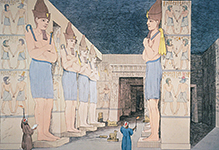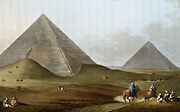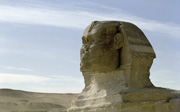
Egypt
Birth and Death,Cult and Gods,Pharaos and Officials,Pyramids and Temples,Daily Life.

#030102 5
Figure of a man with a hoe, from Assiut, Egypt, 6th Dynasty, c2250 BC. By the Ne...

#030102 6
Strip of decorated linen, from Egypt, New Kingdom or later, after 1550 BC. The t...

#030102 7
Linen bag of salt for mummification, Egyptian, New Kingdom, c1550-c1070 BC. In i...

#030102 8
Shrine stela of Ineny, Egyptian, late 18th Dynasty, c1350 BC. Shrine, presumably...

#030102 9
Gold cobra wearing the crown of Lower Egypt, Egyptian, Late Period, after 600 BC...

#03010210
Obsidian amulet in the shape of two fingers, Egypt, Late Period, after 600 BC. T...

#03010211
Faience vessel decorated with a depiction of the god Heh, from tomb 61,Enkomi, c...

#03010212
Mummy of a cat, from Abydos, Upper Egypt Roman period, perhaps 1st century. Ani...

#03010214
Coffin of a woman, Egyptian, Early Roman period, 1st BCE- 1st CE. Anthropoid cof...

#03010215
Terracotta figurine of a woman riding on a pig, Hellenistic, Egypt, 1st BCE. It...

#03010220
Sphinx with proto-Sinaitic inscriptions, from Serabit el-Khadim, Sinai, Middle K...

#03010222
Pair of disc and amphora earrings, Hellenistic (Ptolemaic), c200 BC. Earrings wi...

